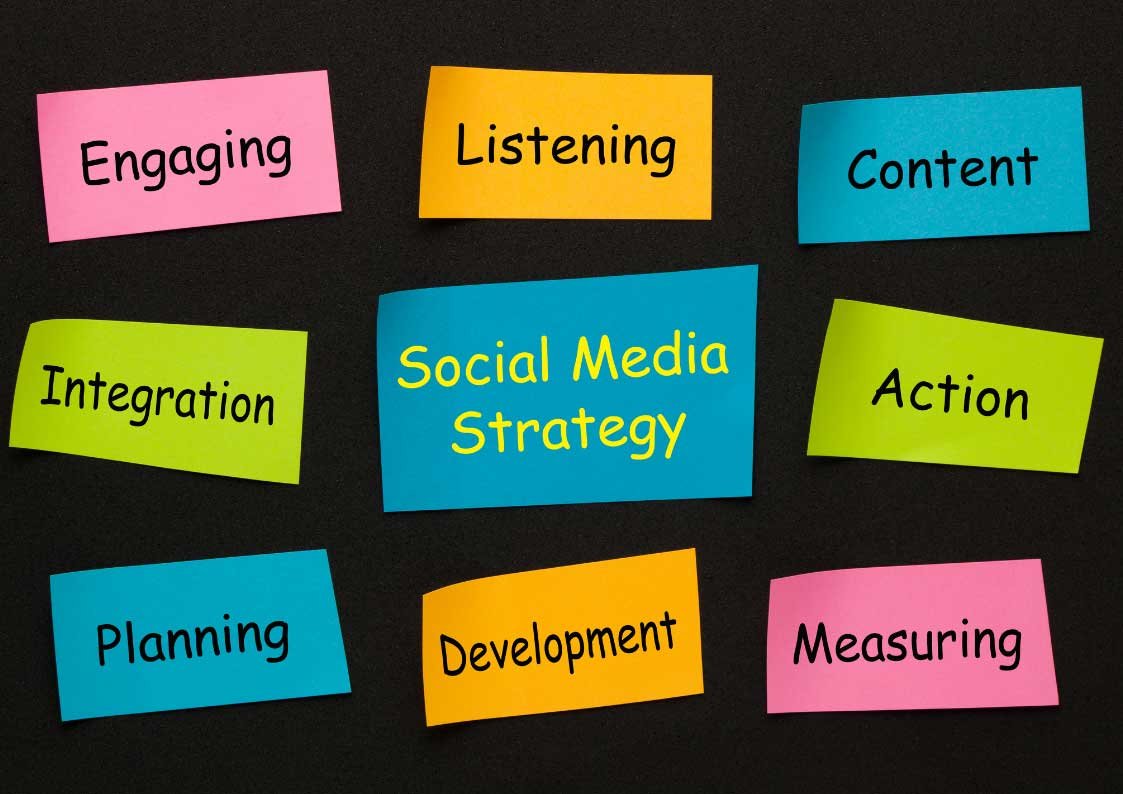What is a Social Media Strategy?
A social media strategy is a document outlining your goals, tactics and metrics for social media marketing. It can also list your existing and planned social media accounts and goals specific to each platform you’re active on.
Your social media marketing strategy should define the roles and responsibilities within your team and outline your reporting cadence. A social media strategy is the master plan for how a business or organisation wants to use their social media- it encompasses all marketing activities, from creative plans to posting cadence to engagement strategies.
Why you need a Social Media Strategy
Almost every business is using social media somehow, but many are not seeing the results they want. This is often because they don’t have a social media strategy. A social media strategy can help set goals and guardrails, track performance, and benchmark over time. Most importantly, it helps team members understand their role in the overall process.
You can share too much promotional material without negatively impacting your audience growth or engagement rates when you have a social media strategy. On the other hand, if you publish too much entertaining or informative content without any promotional material, your brand will seem less credible, and people may lose interest over time.
A successful social media strategy balances promotional and non-promotional content while providing valuable information to followers. Additionally, businesses should consider working with influencers to reach new audiences and promote their brand.
Things you must know in creating your Social Media Strategy
1. Why does your business want to be on Social Media?
There are many reasons why a business might want to be on social media. Some of the most common reasons include:
- To improve awareness of your brand.
- To increase traffic to your website.
- To generate leads.
- To grow revenue.
- To boost engagement and community growth.
Each goal should be tailored to match the specific needs of the business. For example, if you’re looking for more website traffic, you’ll need to create content that is interesting and relevant enough to compel people to visit your site. If you’re wanting to increase brand awareness, then you’ll need to create a social media plan that will get your name in front of as many people as possible.
2. Who is your target audience?
Before you can start creating content, you need to know who your target audience is. This means understanding their demographics (location, age, gender, income level) and psychographics (what motivates them, what are their interests).
You can create personas to help you understand how different audiences might respond or react to your content marketing strategy. A persona is a representation of your target audience. It includes demographic information and psychological insights. Personas help you create strategies and know what content to produce. You can use this information when determining the frequency and tone of your social media posts.
3. What are you going to share?
When it comes to social media marketing, one of the most important things you need to figure out is what you’re going to share. Themes are a great way to organise your content and can help keep your social media accounts looking fresh.
You don’t want to just share whatever you feel like – that’s not very strategic. Instead, come up with a few themes that reflect the type of content you want to share on social media. This could be based on the brand itself or on types of content (photos, videos, etc.).
4. Where are you going to share?
Not all social media platforms are the same, so you’ll want to consider where you should share your content. For example, LinkedIn is a great platform for B2B brands because it’s oriented toward professionals. Instagram is great for visual content, while Twitter can be used to share longer-form content.
It’s wise to at least have a complete profile on Facebook, Instagram, Twitter, and LinkedIn in case people search for your brand online. You may also want to consider other platforms like Snapchat, Pinterest, or YouTube based on where your audience is most active.
5. When are you going to share?
When deciding when to post, consider the behaviours of your target audience. What times are the most active on social media? When do they check their phones or computers?
Don’t jump into research for the best time before you decide which days and times to post. Social media marketing strategies are often dependent on the time of day. For example, people who love to travel might be more active during the weekends, and mothers might be more active when their kids are asleep in the middle of the night.
Social media marketing strategies are different for every audience. The best time to post is based on the behaviour patterns of your target audience, not a universal rule.
6. Finally, how are you going to execute this strategy?
Now that you have a social media marketing plan, it’s time to put it into action! But before you do, there are a few things you need to keep in mind.
First, make sure your plan is solid. This means that it should be an outline of what you want to do and when with specific goals in mind for the end result. Second, remember that a successful social media strategy requires an ongoing commitment of time and resources. And finally, don’t forget that putting together a strong social media team can help overcome many challenges along the way!
Once you have your team in place, it’s time to start executing your strategy. This will involve writing content, designing visuals, taking photos and videos, brainstorming ideas,…the list goes on! But if you break it down into manageable steps and stay focused on your goal, you’ll be well on your way to success.
How to create a Social Media Strategy
1. Define your target audience.
Before you can create a social media strategy, you need to define your target audience. This involves understanding who your ideal customer is and what their needs are. Once you know this information, it will be easier to develop content that resonates with them and creates conversions. You can use buyer personas to help with this process.
2. Start blogging
One of the best ways to create a social media strategy is to start blogging. This involves creating quality content on a consistent basis. As you compile a list of common questions from prospects, make a commitment to address these questions with at least one blog post per week. Additionally, consider featuring customer stories on your blog. These can be very powerful, as they help illustrate the real-world impact of your product or service.
3. Create educational content.
One way to create valuable content for social media is to produce educational content. This type of content can help you build a relationship with your audience by providing them with useful information. Additionally, it can help you establish yourself as an expert in your field.
When creating educational content, make sure that it is relevant to your target audience and provides them with real value. Also, be sure to keep it concise and easy to consume – people are more likely to read shorter pieces of content that are well-written and informative. Finally, promote your educational content through social media networks like Facebook or Twitter, and watch as leads start flowing in!
4. Focus on a few key social channels.
Social media presence isn’t always a priority for all companies. In fact, some businesses may only have a Facebook page and not much else. This is usually because those businesses didn’t take the time to strategise and figure out which channels would work best for them.
It’s important to focus on one channel before moving on to another, starting small and building up slowly. You’ll also want to make sure that your company has the resources in place – such as manpower and budget – to support social media campaigns before launching them.
5. Develop a recipe card to guide you.
Creating a social media strategy can be overwhelming. It’s important to have an actionable plan that you can follow, with a focus on posting and engagement frequency. Here are some tips:
- A recipe card should be realistic, achievable, and inspiring.
- Define your target audience before you start blogging or creating educational content.
- Focus on a few channels rather than spreading yourself thin across many platforms such as Facebook, Instagram, LinkedIn etc.
- Start small and try to keep experimenting with your social media strategy.
- Before you can fine-tune your strategy, you need to start somewhere. Social media takes time to build up a following, establish your brand, and generate consistent results; over time, adjust recipe cards and content based on feedback received from audience reactions.
6. Measure your results.
Now that you’ve been publishing content regularly, it’s important to measure your results. This will help you determine what’s working and what isn’t, so you can make changes as needed.
There are a number of simple metrics you can track, such as:
- The average post response rate: This is an indicator of how interesting your message is to people.
- Trends in interest rates on particular topics or keywords which generate more interest than others.
- Social media metrics: These can be used to measure how successful a social campaign has been. Simple metrics typically include net new fans and followers, number of interactions, and website visits from social media.
7. Adjust your tactics
Just as you should constantly be adjusting your social media goals based on your findings, you should also be adjusting your tactics. What works one month may not work the next – so it’s important to always be testing and measuring.
Remember that social media is all about giving people what they want when they want it. So experiment with different content types, posting schedules, and engagement tactics to see what works best for your audience.
Don’t forget to update your strategy based on changes in Facebook’s algorithm or user behaviour!
Choosing your Social Media Channels
When it comes to social media marketing, it’s important to tailor your strategy to each platform. Not doing so can mean building your presence on too many channels and creating more work for yourself.
- Instagram is a popular marketing channel – its visual mediums like photos, videos, and filters are perfect for building a following. However, if you want to share an organic message or valuable information with your audience, Instagram may not be the best option.
- Twitter is great for sharing quick thoughts and promoting posts, but its 280-character limit can make it difficult to provide in-depth information.
- LinkedIn excels at providing professional content and reaching business professionals.
- Facebook can be used for delivering targeted ads and has a global viewer base.
Social Media Marketing Tactics
A social media marketing strategy is a document listing goal specific to each platform. For example, you might want to increase brand awareness on Twitter or generate leads on LinkedIn. A social media strategy should be created to measure progress and goals aligned with your business’s larger digital marketing strategy.
Creating a social media plan should include defining roles and responsibilities. Who will be creating content? Who will be moderating comments? Who will liaise with other teams within the company (e.g., PR)? Defining these roles early on will help ensure everyone knows their responsibilities and can work together effectively.
Social media marketing is a must for your advertising strategy; it helps to increase engagement and reach by targeting audiences that are more likely to take action on your product. In fact, according to recent studies, 92% of marketers who use social media believe it delivers good or great ROI. So, if you’re not included do not include your marketing mix, you’re missing out on a lot of potential leads and revenue.
Social Media Marketing Strategy FAQ
What Is a Social Media Strategy?
A social media strategy is a document that outlines your goals, tactics and metrics. It’s important to remember that your social media marketing plan should align with your business’s digital marketing strategy. That means that all of your online marketing efforts should work together to achieve common goals.
Once you have a solid understanding of what you’re trying to achieve, it’s time to start figuring out the who, what, where, when and how of your social media campaign/marketing plan. You’ll need to define the roles and responsibilities within your team to ensure a successful social media campaign.
Your social media strategy will outline how a business will create, post, and measure all its social media marketing activities. But don’t forget: the goal of a social media strategy is to increase engagement. Increasing engagement can lead to website visits, leads and sales- so make sure you set measurable objectives!
A Social Media Strategy encompasses the following three parts: Guidelines, Cadence, and Creative Plans
Why Is a Social Media Strategy important?
A social media strategy is important for a number of reasons. First, it’s an investment – but it’s worth it. Social media marketing strategies focus on creating content and a campaign plan to keep your objectives in mind.
Second, social media is huge. Half the world uses social media regularly, so brands should be engaging with them to grow their following online.
Third, a social media strategy helps you achieve success in other aspects of your business, like research and metrics. Finally, know your audience – it’s key to success on social media! By understanding who they are and what they want, you can create relevant content that engages them and builds relationships with followers.
What are the main Social Media Marketing strategies?
There are four main social media marketing strategies, which are:
- Promotion- this is the most common type of social media marketing and refers to using platforms to share your content with a wider audience to increase brand awareness.
- Price- this strategy uses discounts or price changes as a way to at customers or encourages current ones to buy more products.
- Place- this strategy focuses on how you distribute your products and services through different channels.
- Packaging- this strategy is all about how you present your products and services online and offline.
The 11 elements of a successful Social Media Marketing Strategy
1.) Branding
It’s important that the same guidelines are applied to a company’s social media branding. This includes the company’s logo, fonts, colours and voice. The goal is to create a consistent brand across all social media platforms.
Who will represent (or represents) the voice of your company in your social media branding guidelines? This is an important question that needs to be answered before developing any guidelines. The ideal candidate should have a deep understanding of the company and its target audience. They must also be able to write in a way that engages with customers and followers.
2.) Content
Creating quality content is essential for a successful social media marketing strategy. Content can be presented in a variety of formats, including blog posts, photos, videos and presentations. When you create content, think about how you can help your audience and build trust with them.
Blogs should be part of every company’s social media marketing strategy. They are a great way to share your knowledge and expertise with your audience and promote your products and services. To make the most of blogs, make sure they are well-written, keyword-rich, and optimised for search engines.
Choose the right platforms for your content. If you’re not sure where to start, consider the demographics of each platform and what type of content will work best there. Also, decide if you want to use paid or organic methods to reach your target audience. Tools like Hootsuite can help manage your social media efforts across multiple platforms. Use the right tools to help manage your social media efforts. There are a number of great tools out there that can help automate tasks like scheduling posts and tracking mentions. Hootsuite offers a free trial so you can try out different tools and find the ones that work best for you
3.) Curation
It’s important to share content that your followers find interesting. Curating content from sources you find interesting can help establish thought leadership in social media marketing.
When you curate content, you are providing your audience with information they want and need. You are also establishing yourself as a credible source of information in your field. Additionally, crowdsourcing content can be found on social media and through your own fan base. This gives you access to a wealth of information that can help you create engaging and informative posts for your followers.
4.) Channels
Presence on social media sites is not limited to just one or two but can include more than 26. To be successful, businesses must have a strategic plan for each channel they are active on. Internal best practices and tactical plans will help with engagement on each channel individually.
5.) Frequency
It’s important to decide which social media platform you want to focus on and tailor your frequency strategy for that specific purpose. For example, if you’re targeting Facebook users, post strategically – a single post gets more likes and comments than twice-a-day posts. However, if Twitter is your focus, aim to tweet multiple times per day to increase the chances of being seen by more people. And don’t forget about Google+, where posting once or twice a week is ideal. Finally, always be aware of the average time it takes users to engage with posts before posting again
6.) Engagement
There is no one-size-fits-all answer to social media engagement, as it will vary depending on the brand and industry. However, some general best practices include:
Reactive and proactive engagement should be considered equally important to create a successful strategy.
Engagement should not be the objective but rather used as a tactic to help achieve objectives. For example, increasing website traffic or generating leads.
The engagement rate of followers and fans is a key indicator that you are successful on social media. Measuring this metric will help you determine if your social media efforts are paying off.
7.) Social Listening
Social listening is the general term for being actively engaged with social media users. This means monitoring conversations and engaging with customers who have questions, complaints or compliments. Social listening can help marketers understand potential future trends, benefits and customer feedback. Additionally, it can be used to track brand sentiment and measure the success of marketing campaigns.
A social listening strategy is a must for companies who want to improve customer experience and reduce complaints. The most important element of a social media marketing strategy is authenticity and engaging with your audience. It’s also important to be timely in your responses.
8.) Campaign
There are many potential benefits of campaigns. For example, a recent study by Facebook found that users who click on a “pick your favourites” ad campaign post go on to share it with friends.
In order to create successful social media marketing campaigns, businesses now have more than one social account and tie them together with cross-channel campaigns. This way, they can ensure content is tailored differently depending on each network’s audience.
However, it is important to remember that each social media platform has its own idiosyncrasies and values that must be considered when creating a strategy. For example, Instagram is the most popular social media platform for hashtags, which means it is important for marketers to use them on Instagram and other networks.
9.) Influencer Marketing
So, what is influencer marketing? Influencer marketing can be described as a form of marketing that focuses on using key individuals – called influencers – to persuade others to take action. These influencers can be discovered through a variety of methods and, for the most part, are passionate about what they do and want to show off their work. In other words, they’re already doing your content marketing for you!
Content marketing plays a big role in social media – if you are not engaging with the right people with your content (influencers), it will likely fail to reach its full potential. As such, social media should be considered as one part of your overall marketing strategy. And while influencer marketing allows you to direct customers and gain more exposure for your brand on social media, it’s important to remember that this tactic should not overshadow other aspects of an effective digital marketing plan.
10.) Brand Ambassadors (including Employee Advocates)
Not all brand ambassadors are employees. In fact, 92% of people trust recommendations from friends and family more than marketing. So how do you create a successful social media marketing strategy that targets these valuable individuals?
Internal employees should be encouraged to act as brand ambassadors, with the goal of increasing loyalty and amplification. Brand advocates are people who already like and promote your brand- they may not have the same reach as influencers but they will have a large audience and solid reputation.
11.) Crisis Management
While social media has the potential to be a powerful communications tool, it also has the potential to lead to crisis communications. In order for companies to be prepared for such a situation, they should have a plan in place for each of the channels that are going to be used. A recent study showed that 76% of social media crises could have been reduced or avoided with proper investments into social media marketing strategies.
It’s important for companies to remember that their social media marketing strategy should be based on the needs of each department. The 11 essential components of a successful social media marketing strategy are a bare minimum, but companies may also want to consider other ingredients such as budgeting and branding which are not included in this list.
Putting Social Media Strategy into practice
When it comes to social media, many companies struggle with how to put their strategy into practice. This is often because they lack a clear plan of action or because their goals are not well-defined. Without objectives, it’s difficult for companies to measure their success and make course corrections as needed.
There are a few different ways that companies can go about implementing their social media strategy: the predictive practitioner approach, the creative experimenter approach, and the social champion approach. The predictive practitioner approach is designed for organisations that want to see quick results and have a defined goal for using social technologies. The creative experimenter approach is better suited for firms that are willing to experiment and learn from their mistakes. Finally, the social champion strategy helps companies identify influencers and get them on board with company initiatives outside of the organisation (or inside).
Is your Social Media Marketing Strategy sorted out for 2022?
It’s no secret that social media is a powerful communication tool. But what may surprise some businesses is just how much social media can do for their bottom line. In order to get the most out of social media, it’s important to have a well-defined strategy in place.
Thankfully, this guide offers ways to set actionable goals and address each of the steps mentioned in the article. And if you’re looking for help in creating your social media strategy, we suggest you reach out to Ubique Digital Solutions, we are ready to walk you through creating and implementing a tailor-fit social media strategy for your company! Partner with us and see yourself reaching your goals.




















